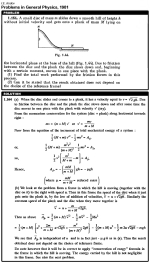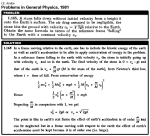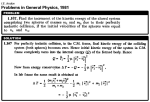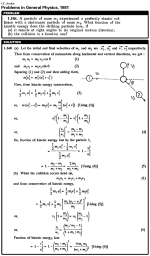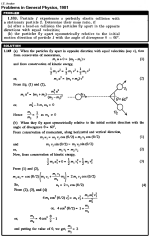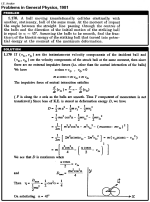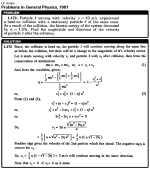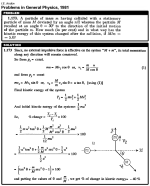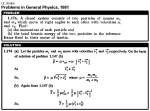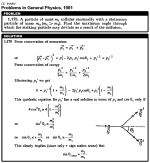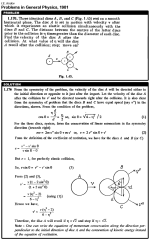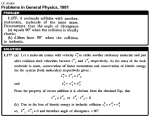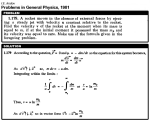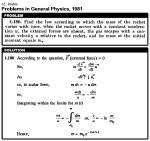| № |
Condition |
free/or 0.5$ |
| 161 | A cannon of mass M starts sliding freely down a smooth inclined plane at an angle α to the horizontal. After the cannon covered the distance l, a shot was fired, the shell leaving the cannon in the horizontal direction with a momentum p. As a consequence, the cannon stopped. Assuming the mass of the shell to be negligible, as compared to that of the cannon, determine the duration of the shot. |
|
| 162 | A horizontally flying bullet of mass m gets stuck in a body of mass M suspended by two identical threads of length l (Fig. 1.42). As a result, the threads swerve through an angle θ. Assuming m << M, find: (a) the velocity of the bullet before striking the body; (b) the fraction of the bullet s initial kinetic energy that turned into heat. |
|
| 163 | A body of mass M (Fig. 1.43) with a small disc of mass m placed on it rests on a smooth horizontal plane. The disc is set in motion in the horizontal direction with velocity v. To what height (relative to the initial level) will the disc rise after breaking off the body M? The friction is assumed to be absent. |
|
| 164 | A small disc of mass m slides down a smooth hill of height h without initial velocity and gets onto a plank of mass M lying on the horizontal plane at the base of the hill (Fig. 1.44). Due to friction between the disc and the plank the disc slows down and, beginning with a certain moment, moves in one piece with the plank. (1) Find the total work performed by the friction forces in this process. (2) Can it be stated that the result obtained does not depend on the choice of the reference frame? |
|
| 165 | A stone falls down without initial velocity from a height h onto the Earth s surface. The air drag assumed to be negligible, the stone hits the ground with velocity v0 = sqrt(2gh) relative to the Earth. Obtain the same formula in terms of the reference frame "falling" to the Earth with a constant velocity v0 . |
|
| 166 | A particle of mass 1.0 g moving with velocity v1 = 3.0i - 2.0j experiences a perfectly inelastic collision with another particle of mass 2.0 g and velocity v2 = 4.0j - 6.0k. Find the velocity of the formed particle (both the vector v and its modulus), if the components of the vectors v1 and v2 are given in the SI units. |
|
| 167 | Find the increment of the kinetic energy of the closed system comprising two spheres of masses m1 and m2 due to their perfectly inelastic collision, if the initial velocities of the spheres were equal to v1 and v2. |
|
| 168 | A particle of mass m1 experienced a perfectly elastic collision with a stationary particle of mass m2. What fraction of the kinetic energy does the striking particle lose, if (a) it recoils at right angles to its original motion direction; (b) the collision is a head-on one? |
|
| 169 | Particle 1 experiences a perfectly elastic collision with a stationary particle 2. Determine their mass ratio, if (a) after a head-on collision the particles fly apart in the opposite directions with equal velocities; (b) the particles fly apart symmetrically relative to the initial motion direction of particle 1 with the angle of divergence θ = 60°. |
|
| 170 | A ball moving translationally collides elastically with another, stationary, ball of the same mass. At the moment of impact the angle between the straight line passing through the centres of the balls and the direction of the initial motion of the striking ball is equal to α = 45°. Assuming the balls to be smooth, find the fraction η of the kinetic energy of the striking ball that turned into potential energy at the moment of the maximum deformation. |
|
| 171 | A shell flying with velocity v = 500 m/s bursts into three identical fragments so that the kinetic energy of the system increases η = 1.5 times. What maximum velocity can one of the fragments obtain? |
|
| 172 | Particle 1 moving with velocity v = 10 m/s experienced a head-on collision with a stationary particle 2 of the same mass. As a result of the collision, the kinetic energy of the system decreased by η = 1.0%. Find the magnitude and direction of the velocity of particle 1 after the collision. |
|
| 173 | A particle of mass m having collided with a stationary particle of mass M deviated by an angle π/2 whereas the particle M recoiled at an angle θ = 30° to the direction of the initial motion of the particle m. How much (in per cent) and in what way has the kinetic energy of this system changed after the collision, if M/m = 5.0? |
|
| 174 | A closed system consists of two particles of masses m1 and m2 which move at right angles to each other with velocities v1 and v2. Find: (a) the momentum of each particle and (b) the total kinetic energy of the two particles in the reference frame fixed to their centre of inertia. |
|
| 175 | A particle of mass m1 collides elastically with a stationary particle of mass m2 (m1 > m2). Find the maximum angle through which the striking particle may deviate as a result of the collision. |
|
| 176 | Three identical discs A, B, and C (Fig. 1.45) rest on a smooth horizontal plane. The disc A is set in motion with velocity v after which it experiences an elastic collision simultaneously with the discs B and C. The distance between the centres of the latter discs prior to the collision is ri times greater than the diameter of each disc. Find the velocity of the disc A after the collision. At what value of rl will the disc A recoil after the collision; stop; move on? |
|
| 177 | A molecule collides with another, stationary, molecule of the same mass. Demonstrate that the angle of divergence (a) equals 90° when the collision is ideally elastic; (b) differs from 90° when the collision is inelastic. |
|
| 178 | A rocket ejects a steady jet whose velocity is equal to u relative to the rocket. The gas discharge rate equals n kg/s. Demonstrate that the rocket motion equation in this case takes the form mw = F — hn where m is the mass of the rocket at a given moment, w is its acceleration, and F is the external force. |
|
| 179 | A rocket moves in the absence of external forces by ejecting a steady jet with velocity u constant relative to the rocket. Find the velocity v of the rocket at the moment when its mass is equal to m, if at the initial moment it possessed the mass m0 and its velocity was equal to zero. Make use of the formula given in the foregoing problem. |
|
| 180 | Find the law according to which the mass of the rocket varies with time, when the rocket moves with a constant acceleration w, the external forces are absent, the gas escapes with a constant velocity u relative to the rocket, and its mass at the initial moment equals m0. |
|



